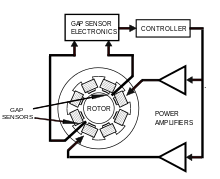Magnetic bearings
Magnetic bearings enable storage without material contact through magnetic forces .
Types
Passive magnetic bearings
According to the Earnshaw theorem , it is not possible to build passive and non-contact magnetic bearings by exploiting ferromagnetism. This is only possible through the use of diamagnetic materials. Since diamagnetism is very weak at normal temperatures, passive magnetic bearings can in fact only be implemented as " superconducting magnetic bearings ". Because of the Meissner-Ochsenfeld effect or “flux pinning”, superconductors displace magnetic fields and thus exert a force on externally applied magnetic fields.
Active magnetic bearings
With active magnetic bearings, the bearing force is generated by regulated electromagnets, the stability of the system is ensured by suitable feedback and electronic control. The basic invention of such a control goes back to the German engineer Hermann Kemper, who applied for a patent in 1934.
Combinations with permanent magnets are often used as active magnetic bearings. The combination with or integration into an electric motor is called a bearingless motor .
Active magnetic bearings require a constant power supply and have a mechanical backup bearing, usually consisting of a loose ball or slide bearing, to protect against power outages or failures of the control.
Electrodynamic magnetic bearings
There are also special types such as "electrodynamic magnetic bearings" (generate the bearing force through eddy currents, mostly without electronic control).
Comparison with other technologies
advantages
- Freedom of contact:
- Storage possible through hermetic encapsulation
- No abrasion, which is important for a dust-free environment
- No wear on the bearing, which makes maintenance easier
- No lubricants necessary, e.g. B. evaporate in a vacuum or with the u. U. can react to aggressive surroundings
- Thermal, electrical and mechanical insulation between the bearing and the supported body
- Low losses due to friction work
- High speeds
With active magnetic bearings there are further advantages:
- The bearing force can be influenced
- Damping and stiffness can be varied during operation
- Vibrations and imbalances can be actively dampened
- Electronic monitoring and control of the warehouse possible
disadvantage
- Complexity and effort
- Relatively low force density (up to about 40N / cm²)
- Space requirement
- Requirement for auxiliary energy, e.g. B. electrical energy to operate electromagnets
Applications
Typical application examples are gas ultracentrifuges , turbo molecular pumps , tool spindles , compressors and expanders , hose pumps , flywheels and magnetic levitation trains .
Web links
Individual evidence
- ^ A b Johan K. Fremerey: Permanent Magnetic Bearings. November 2000, accessed September 7, 2014 .
- ^ Gerhard Schweitzer, Alfons Traxler, Hannes Bleuler: Magnetlager. Springer 2013, ISBN 978-3-662-08449-6 .

